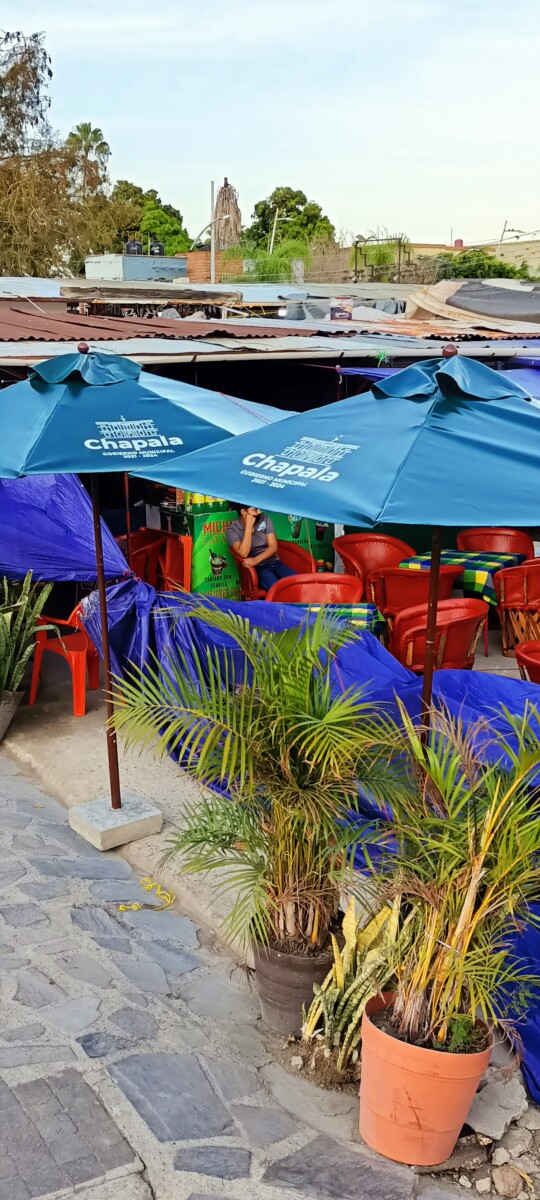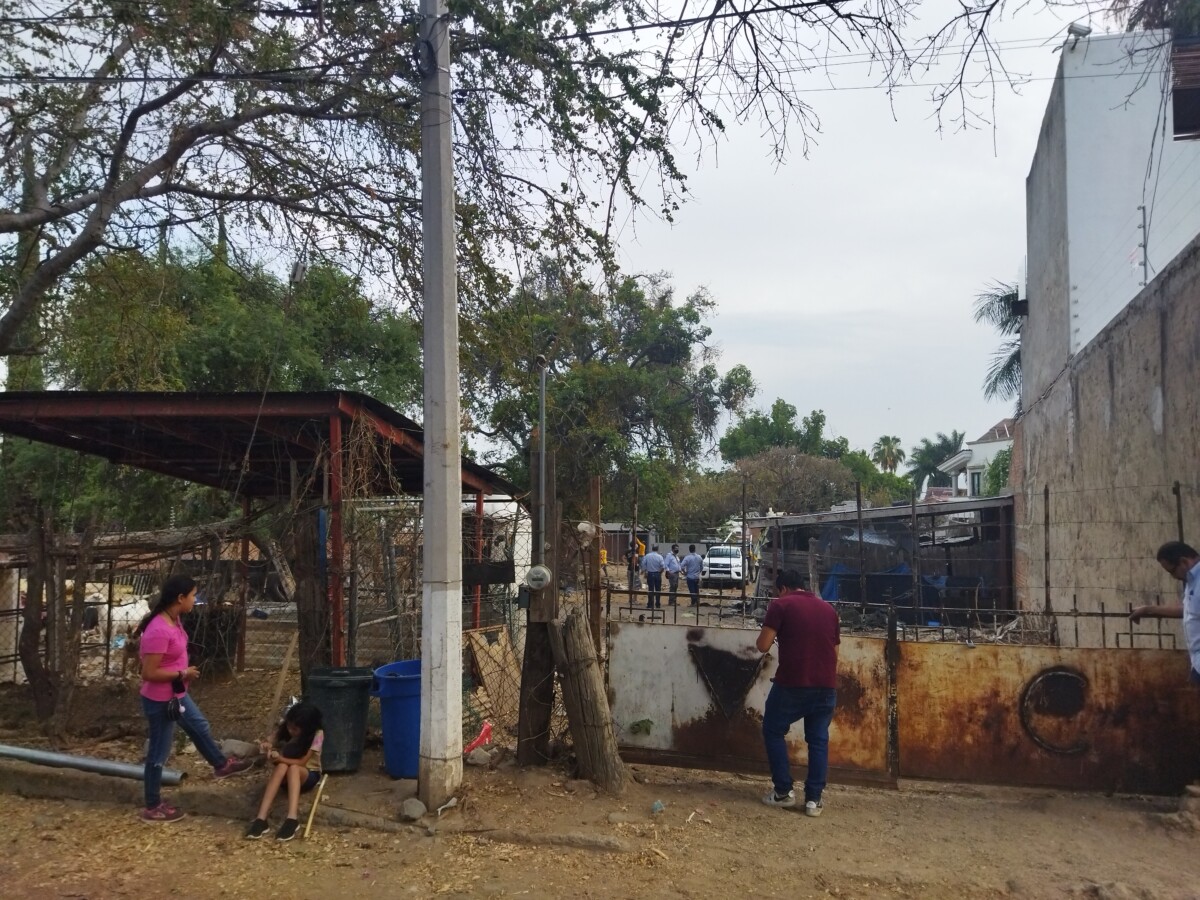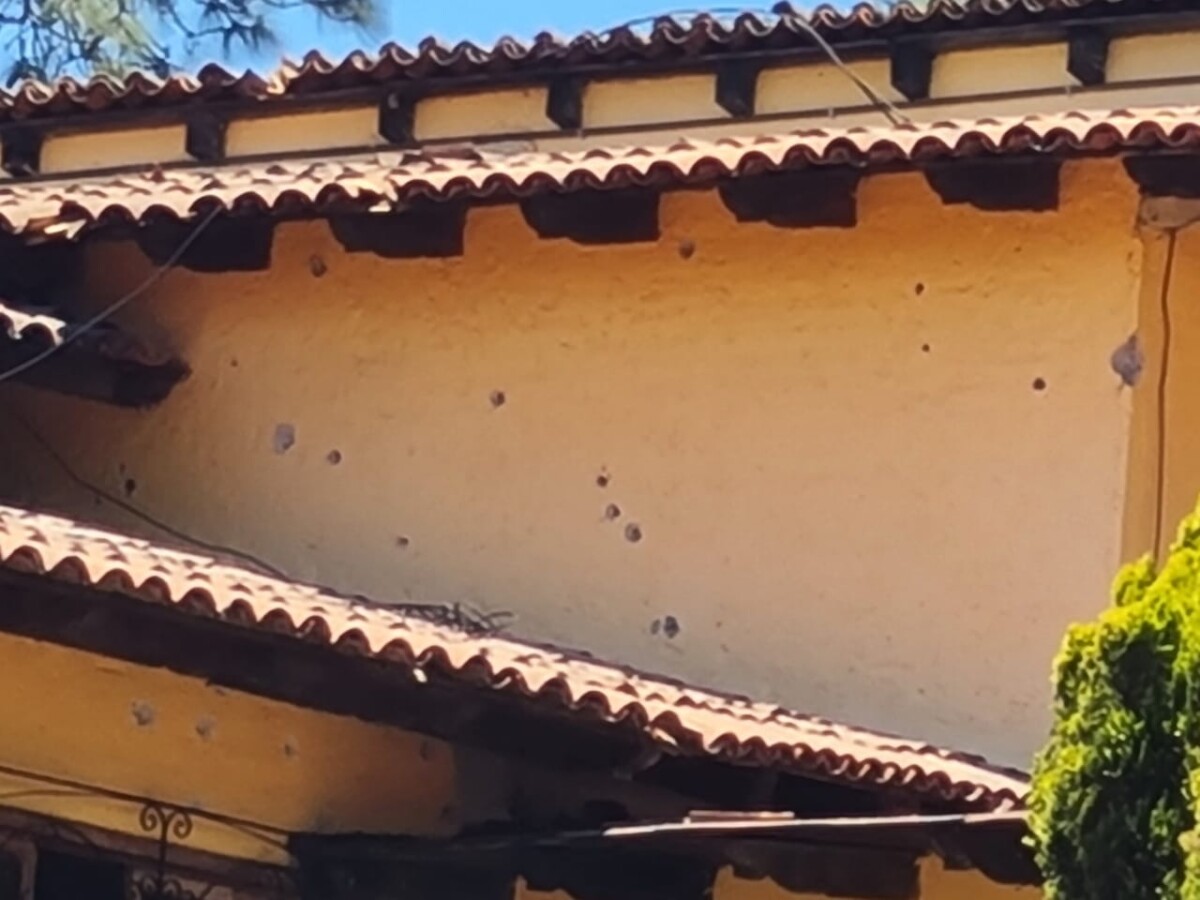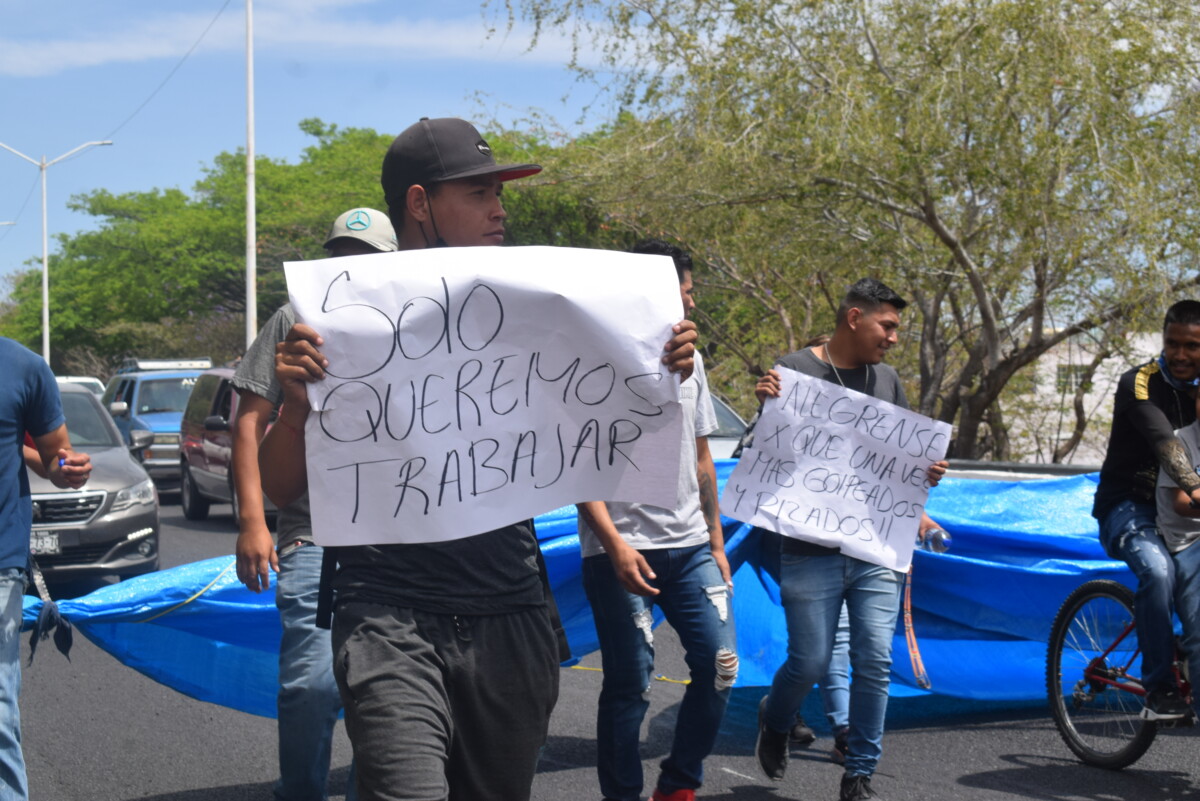noticias
Complaints of attempted dispossession by ‘real estate mafia’ increase
Irregular entrance to a property located in La Canacinta, on Lirios Street. Photo: Archive.
Editor.- At least four cases of alleged attempts of property dispossession have surfaced in recent months in the municipality of Chapala, thanks to legitimate owners and citizens who pointed out irregularities in the paperwork of the properties and in the actions of the authorities and former officials involved.
The last case occurred last Wednesday, April 27, in the area of La Canacinta, west of Ajijic, on Lirios Street, where José Contreras Ortega has owned a property for approximately 55 years, which is now in court because people claiming to own the property have appeared.
Although there has been no resolution of the litigation, the supposed new owners, with the help of lawyers, workers and municipal police -who witnesses said that they were mocking and arrogant-, forced their way onto the property containing some of Contreras Ortega’s belongings and livestock.
Both José Contreras Ortega and his relatives said that, being an elderly man and unable to read and write, these characters took advantage of him, denying that anyone other than him could read the documents they had, and only giving his family a notice of a hearing to occur.

Machine used for the attempted eviction in La Floresta, in Ajijic. Photo: Facebook.
«They wouldn’t show us anything. If it was real, they would have a judge’s verdict, eviction order or something. They just gave us a notice for a hearing that is scheduled for May. The lawyer is the one who has been handling the case, as my father does not know how to read or write, he just gives him the corresponding payments to do things,» said one of Don José’s daughters. Some other witnesses pointed out that this lawyer has been linked to irregular legal processes.
In the end, the Contreras family opted to take legal action the following day, presenting their evidence and the notification they never received, claiming they thought that the trial was still ongoing. As a result of this situation, Contreras Ortega had to move their cattle to a property that was loaned to them next to the one where they were originally located.
On Saturday, April 23, several people affected by the attempted dispossession met to tell their cases to the media. Both the Ibon family from Ajijic and the López family from Santa Cruz de la Soledad, along with a member of the Indigenous Community of San Antonio Tlayacapan, presented their cases, linking the Covarrubias brothers to the dispossession of Ajijic and Santa Cruz, and mentioning several former presidents involved in the Chapala ejido, which has sought to appropriate the communal land of San Antonio.
In this meeting, the names of both municipal authorities and ex-officials, as well as institutions such as the Pension Institute of the State of Jalisco (IPEJAL), were mentioned, which they described as «bribed» or «sold».
All the affected families agreed that they will publicize all the cases and all those involved, so that precautions and actions are taken against those involved.
Translated by Patrick O’Heffernan
Vendors in Jocotepec abandon their stalls in the market due to low sales
Abandoned wooden modules in the Municipal Market of Jocotepec each costing $7,500 pesos, Photo: Héctor Ruiz.
Héctor Ruiz Mejía – Jocotepec: They threw in the towel. The street merchants who were relocated to the upper floor of the Municipal Market of Jocotepec decided to abandon their stalls after months of low sales.
Vendors interviewed by Laguna said that after a little more than three months of «going through an odyssey» to receive some solution or support from the City Hall to cushion the difficult economic situation they suffered after being relocated, they have opted to move to other places to sell their merchandise.
«I actually had to look for a job. This is over. We tried and fought, but we were left with no response and no support. So I too, like everyone else, am leaving,» commented one of the last vendors.
Semanario Laguna toured the second floor of the building last Tuesday, April 26th , at noon and found that, despite the more than ten million pesos invested in a rehabilitation project that would «give life» to the commercial space, it was empty.
Products such as cooked nopales, cambray onions, chopped and bagged vegetables, avocados and radishes, to mention a few, which not only energized the streets and sidewalks of the town, but were the livelihood of more than 30 families selling on Morelos Street on the outskirts of the market, are no longer for sale.
In addition to looking for another livelihood, some of the affected vendors opted to move to other parts of the town, and even decided to «try their luck» in the neighboring towns of Ajijic and Chapala to continue doing the only thing they know: selling products on the sidewalk, an activity they were no longer allowed to do in Jocotepec.
«It is a shame that they are leaving, I always used to buy my nopalitos and vegetables here with the lady, but when they moved her, it was difficult for my mother and me to go up there; and now we will have to look for someone else,» commented one of the consumers.
Of the ten wooden vendor stands installed on the upper floor of the market to relocate the street merchants, costing approximately $7,500 pesos each, only two are now being used.
City Hall has remained tight-lipped about the situation. After several meetings, negotiations and even a demonstration, officials are aware of the monetary difficulties faced by the affected merchants from the beginning of the relocation, but has not issued any statement on the matter.
Translated by Patrick O’Heffernan
First Earth Day celebration is successful, although participation was lower than expected
Opening ceremony on Friday, April 22. Photo: Sofia Medeles.
Sofía Medeles-Ajijic. The first Earth Day commemoration in Ajijic which took place on April 22, 23 and 24 t was a success although participation was lower than the organizers hoped for. The three-day event consisted of a series of conferences and other activities designed to raise awareness about the need to care for the environment.
Between 150 to 200 people attended each day for a total of 500 and 600 people, mostly adults although there were also interested children.
The first day began with an opening ceremony asking permission to the elements and deities to allow the participants to respectfully carry out the programmed activities. During the closing ceremony on the last day, a tribute and offering was made to Lake Chapala.
The conference speakers included activists who work to safeguard the integrity of both the lake and the mountains, such as Manuel Villagómez Rodríguez, Luis Valdivia Ornelas, Raquel Gutiérrez Nájera and the local resident Julio Carmona. There were also music and film presentations, and tables for information and sale of ecological products.
«I think the event was effective both in the professional and academic quality of the presenters, said Noris Binet, who added that, “ I think it was very ambitious to do it in three days since it demands consistent participation by the public.”
Binet explained that, “ There were three relevant focuses of the event: that battles of this type can and have been won, that Lake Chapala urgently needs to become a Ramsar site, that a mapping of endangered and reserved areas needs to be done that clearly defines where not to buy or build, something the Expats requested I a petition. ( Lake Chapala is listed on the RAMSAR Information Service as RAMSAR as Ramsar Site no. 1973. For its extensive wetlands).
Sihara Casillas Gaeta, another of the organizers, commented that this type of event helps people to learn about the type of land in which they live, about the local aquifers, and to take stock of how corruption has contributed to the deterioration of natural water reservoirs, which helps convince people to be more vigilant.
Jane Custer, who was in charge of translations at the event, said that she was very pleased to see the Mexican and foreign communities of Ajijic together in one place acquiring knowledge to protect the Lake and the environment.
Noris stated that, in the coming years, she believes the event could improve in terms of local participation, involving neighbors and members of indigenous communities, talking about their problems related to environmental issues. She plans to produce an official document summarizing the most important points of the event to be presented to government authorities, as well as the creation of a citizen and academic observatory to monitor and denounce environmental destruction.
Translated by Patrick O’Heffernan
Opinion: Looking at Life in Lakeside
By: Patrick O’Heffernan
Regional Mexican bands and Latin Acts were shot through the program at Coachella Music and Art Festival last week– twenty Latin acts including four regional Mexican bands.
Near the top was Banda MS from nearby Mazatlán, which got the packed crowd moving with their first hit El Mechón», followed by songs like » El Color de Tus Ojos», «Hermosa Experiencia» and bit of «Qué Maldición», originally recorded with Snoop Dog. Much of the crowd seemed to know the lyrics pretty well, at least from the YouTube videos I have watched (I wasn’t there) .
Latin-Grammy winners Groupo Firme from Tijuana energized a screaming crowd of thousands with their hit “El Toxico” on Day 2. Sunday was the Coachella debut of Natanael Cano, who combines rock, rap and pop and corridos, and Ed Maverick from Chihuahuan with his singer-songwriter folk, alternative and rock music mashups.
Other Latin acts included Karol G, Niki Nicole, Anitta, Alaina Castillo, Nathy Peluso, and the Latin-Canadian Jessica Reyes along with American- Mexican bands Chicago Batman, Cuco, Ela Minus, Omar Apollo, Pabllo Vittar, and The Marias .
So why all the Latin acts and four Mexican regional bands at Coachella this year? A few Latino artists have performed at Coachella since its inception in 2001, including Café Tacvba, Julieta Venegas, Nortec Collective and Los Ángeles Azules, but they really broke through in 2019 with the flamenco fusion artist Rosalía, Bad Bunny, and J Balvin in Main Stage prime spots.
The numbers tell us why Mexican and Latin acts were there this year. MRC, which tracks music trends, revealed in its 2021 Year End Report that Latin music album consumption in the U.S. grew by 21.1% in 2021, more than any other core music genre. The number of Latin albums bought and streamed in the US hit 48.2 million and generated more than US$886.1 million, making Latin music the #5 most-consumed music genre NOB.
Latin bands are now for everyone. Whether it’s Bad Bunny, Karol G, Banda MS, or anyone playing reggaeton, research shows the audiences are of mixed cultures. Spanish lyrics are not a deterrent – people love the Latin beats even if they don’t get the lyrics.
Mexican/Spanish music has been around the US since before there was a US, when colonists from Mexico introduced the guitar to Florida and the Southwest of what is now the US. By the 1930’s California radio stations were playing norteño and mariachi for farm workers. Cuban music landed in New York City in the 40’s with Arsenio Rodríguez, Desi Arnez , and La Lupe. During the rock revolution Latinos were there with songs like “La Bomba”, and “Tequila”, and bossa nova.
This year the regional Mexican band Groupo Firme sold out 7 nights at Staples Center in LA, only one night shy of the record set by Adele, a sign that American music audiences – especially younger fans –resonate with Mexican regional sounds.
So the regional Mexican and Latin bands on the program at Coachella last week were following, not leading, the audience. Coachella2022 was another footstep in the progress of music sin fronteras – music without borders. !Viva musica de Mexico!
Pickpockets operating in Lakeside; more than 17 thefts reported
Sofía Medeles- Ajijic. Purse thefts have been reported in at least 17 places in Lakeside in the towns of Ajijic, San Antonio Tlayacapan, the municipal capital of Chapala and San Juan Cosalá,. The thieves have mostly targeted tourists and Expats.
One of the sites of the incidents was the Lake Chapala Society (LCS) in Ajijic, a popular gathering place for both Expats and local Mexicans. LCS executive director Luis Pacheco assured Laguna that the two mishaps were not violent, but rather accomplished by distracting the victims.
«The two thefts occurred in LCS were not violent,. The thieves – a foreign woman and two Latinos – use a practiced modus operandi. There are at least 17 public spaces and restaurants, or businesses, where robberies of this type have occurred and, in some of them, the thieves identified are the same ones who operated here,» said Luis Pacheco.
According to the LCS executive director, the modus operandi of the pickpockets is that the foreign woman approaches to talk to other tourists or Expat residents to distract them, while the other two people create a barrier and grab their possessions.
Pacheco pointed out that the person in charge of Ajijic’s office, Maximiano Macías Arceo, Chapala Security Commissioner Sergio Conzuelo Ramírez, and the municipal president, Alejandro Aguirre Curiel, are aware of the events, so they are working together to create a crime prevention campaign in the area.
This was confirmed by Macías Arceo who said that this campaign would be focused on training restaurant owners, administrators, block chiefs, etc., in the prevention of crime, and that, although there is still no date to start, it will be announced through the department of Social Communication.
Luis Pacheco said that the most important to reduce crimes is to reestablish the social fabric where neighbors will have co-responsibility and support each other to take care of themselves and educate themselves about this type of crime.
Translated by Patrick O’Heffernan
Women organize to protect themselves from violence in Chapala
Jazmín Stengel- Chapala. The Facebook post of an alleged attempted kidnapping of a student of a language academy and the report of the disappearance of a teenage girl in Chapala, has motivated a group of local women to ask the authorities to guarantee their safety.
The women have organized themselves to collect signatures and ask the authorities for the signage of safe spaces in stores, public and private transport, free courses for self-defense and advertising on the lakeshore to make society aware of the violence to which they are exposed in their daily lives. Several measures are already active in Chapala,sbut the women say they need more.
The women also ask for counseling and protection for victims, free psychological care, a hotline for emergencies and the activation of the purple patrol of female offices.
However some of the measures they ask for have been active in Chapala since the beginning of this administration. For example, there is a purple patrol with six trained female officers that respond to public safety emergency numbers 24 hours a day. The Women’s Institute, located at 69 Niños Héroes Street in the municipality, provides free counseling and follow-up to victims.
The cases that have been reported include the April 22 Facebook post of the private language school People Bilingual Training that one of its students was grabbed by men handing out flyers at the Chapala bus station, who tried to pull her into a parked car in front of the station. The student was helped by a woman selling vegetables and managed to escape.
According to the publications and victims consulted by Laguna, many young women have been chased or stalked by men in cars.
Although one of the threats have been reported to Chapala Public Security or formal complaints filed in the Public Prosecutor’s Office about kidnapping attempts or pursuits of women, Chapala Public Security Commissioner Sergio Conzuelo Ramirez has already ordered stepped-up security strategies and increased citizen information to work on the prevention of crime against women.
Jalisco Strategic Coordinator of Public Security Ricardo Sanchez Beruben said he was not aware of any alleged attempt to kidnap women, since none of the alleged victims have formally filed a complaint.
Sanchez Beruben said that the audio messages that circulated a few days ago warning of the kidnapping of women by criminal groups have circulated in different states of Mexico since 2019.
Translated by Patrick O’Heffernan
Complaints of attempted dispossession by ‘real estate mafia’ increase
Irregular entrance to a property located in La Canacinta, on Lirios Street. Photo: Archive.
Editor- At least four cases of alleged attempts of property dispossession have surfaced in recent months in the municipality of Chapala, thanks to legitimate owners and citizens who pointed out irregularities in the paperwork of the properties and in the actions of the authorities and former officials involved.
The last case occurred last Wednesday, April 27, in the area of La Canacinta, west of Ajijic, on Lirios Street, where José Contreras Ortega has owned a property for approximately 55 years, which is now in court because people claiming to own the property have appeared.
Although there has been no resolution of the litigation, the supposed new owners, with the help of lawyers, workers and municipal police -who witnesses said that they were mocking and arrogant-, forced their way onto the property containing some of Contreras Ortega’s belongings and livestock.
Both José Contreras Ortega and his relatives said that, being an elderly man and unable to read and write, these characters took advantage of him, denying that anyone other than him could read the documents they had, and only giving his family a notice of a hearing to occur.

Machine used for the attempted eviction in La Floresta, in Ajijic. Photo: Facebook.
«They wouldn’t show us anything. If it was real, they would have a judge’s verdict, eviction order or something. They just gave us a notice for a hearing that is scheduled for May. The lawyer is the one who has been handling the case, as my father does not know how to read or write, he just gives him the corresponding payments to do things,» said one of Don José’s daughters. Some other witnesses pointed out that this lawyer has been linked to irregular legal processes.
In the end, the Contreras family opted to take legal action the following day, presenting their evidence and the notification they never received, claiming they thought that the trial was still ongoing. As a result of this situation, Contreras Ortega had to move their cattle to a property that was loaned to them next to the one where they were originally located.
On Saturday, April 23, several people affected by the attempted dispossession met to tell their cases to the media. Both the Ibon family from Ajijic and the López family from Santa Cruz de la Soledad, along with a member of the Indigenous Community of San Antonio Tlayacapan, presented their cases, linking the Covarrubias brothers to the dispossession of Ajijic and Santa Cruz, and mentioning several former presidents involved in the Chapala ejido, which has sought to appropriate the communal land of San Antonio.
In this meeting, the names of both municipal authorities and ex-officials, as well as institutions such as the Pension Institute of the State of Jalisco (IPEJAL), were mentioned, which they described as «bribed» or «sold».
All the affected families agreed that they will publicize all the cases and all those involved, so that precautions and actions are taken against those involved.
Translated by Patrick O’Heffernan
Registran Chapala y Jocotepec sequía ‘severa’, advierte la Conagua
El recrudecimiento del estiaje podría afectar en el abasto de agua potable de la ciudadanía. Foto: Archivo.
Redacción.- Se recrudecerá el estiaje. El Monitor de Sequía de la Comisión Nacional del Agua (Conagua), reportó que Chapala y Jocotepec se encuentran entre los 57 municipios de Jalisco que presentan un nivel de sequía “severa”.
De acuerdo con la actualización del órgano, en 113 de los 125 de Jalisco hay condiciones de sequía entre “moderada” y “severa”, por lo que la afectación por el estiaje será prácticamente generalizada en la entidad.
Junto a las dos poblaciones ribereñas mencionadas, todos los municipios que integran la Zona Metropolitana de Guadalajara (ZMG), así como Colotlán, Mezquitic, Ameca, Tala, Lagos de Moreno y Tepatitlán, son los más afectados por la situación.
La Conagua detalló que en el pasado temporal de lluvias se registró falta de precipitación en la zona de la Sierra Madre Occidental, así como temperaturas más cálidas que el promedio en la Región Centro Occidente del país. Estas causas incrementaron la sequía en Jalisco.
En contraste, son 12 las localidades clasificadas como “anormalmente secas” o sin problemas: Puerto Vallarta, Cabo Corrientes, Cihuatlán, Ayotlán, Cuautitlán de García Barragán, Degollado, Jesús María, Tolimán, Tonila, Tuxcacuesco, San Gabriel y Zapotitlán de Vadillo.
Por otro lado, el Servicio Meteorológico Nacional recordó que la temporada de huracanes iniciará el 15 de mayo en el Océano Pacífico, mientras que en el Atlántico es a partir del 1 de junio . Se proyecta que las lluvias comenzarán a regularizarse en la segunda quincena de junio, con las ondas tropicales, ciclones y el ingreso de humedad.
Con información de El Informador.
Deja tres personas sin vida y varios bloqueos el enfrentamiento armado en Mazamitla
Peritos aseguraron más de mil casquillos percutidos. Foto: Cortesía.
Redacción.- Al menos tres personas sin vida y diversos bloqueos carreteros fue el saldo que dejó el enfrentamiento armado acontecido el domingo primero de mayo en el municipio de Mazamitla, informó la Fiscalía del Estado de Jalisco (FEJ), quien inició con una carpeta de investigación para esclarecer los hechos.
“Los cuerpos de las tres víctimas presentaban impacto de arma de fuego en cráneo, dos de los masculinos tenían aros aprehensores; los cuerpos de los tres hombres quedaron bajo resguardo de Ciencias Forenses con la finalidad de que se les realicen los dictámenes de ley”, detalló en un comunicado la FE.
Al lugar arribó personal ministerial, así como peritos del Instituto Jalisciense de Ciencias Forenses para el levantamiento de indicios, asegurado en el punto cuatro casquillos del calibre .223 milímetros, un casquillo del calibre 7.62 milímetros, así como diversos indicios.
De acuerdo con las primeras investigaciones los hechos ocurrieron alrededor de las 13:50 horas al exterior de un negocio denominado Night Club Loma Encantada, ubicada en Carretera Quitupan la Cofradía kilómetro 24+200, en la localidad La Estacada en el municipio de Mazamitla, en donde se presentó un enfrentamiento entre civiles presuntamente integrantes de un grupo delictivo y se presume fueron privados de la libertad tres masculinos, los cuales fueron abandonados sin vida posteriormente aproximadamente a 10 minutos del bar.
Como consecuencia de los hechos ocurridos, se implementó un operativo para dar con los responsables en el que participaron elementos de la Fiscalía Estatal, la Secretaría de Seguridad Jalisco, la Secretaría de la Defensa Nacional, la Guardia Nacional así como elementos de las policías municipales de la región, quienes al estar realizando labores de vigilancia, localizaron en la glorieta del Camino a Monte Verde los cuerpos de tres masculinos, por lo que se le dio parte a esta representación social.
Fue también que por varios reportes al número de emergencia que al arribar al municipio elementos de la Policía Municipal, así como de la Secretaría de la Defensa Nacional, localizaron un vehículo el cual presentaba múltiples impactos de arma de fuego, así como daños por proyectil de arma de fuego en la fachada del negocio mencionado, por lo que solicitaron mando y conducción al agente del Ministerio Público.
En el lugar se aseguraron además dos automotores con impactos de proyectil de arma de fuego, una puerta de una camioneta la cual contaba con blindaje, además se aseguraron más de mil casquillos de arma de fuego, tanto en el exterior como en el interior del negocio.
Posterior a este evento se cuenta con diversos reportes de al menos cuatro bloqueos carreteros intencionales en tres puntos diferentes que conectan el municipio de Mazamitla con otras localidades del estado de Jalisco.
Los dos primeros bloqueos se presentaron en la carretera que va de Mazamitla a Tuxcueca, donde en un primer punto se obstruyó la vialidad con un camión de carga pesada el cual transportaba grava, y metros adelante se localizó una camioneta tipo pick up a la cual se le prendió fuego.
El tercero de los bloqueos se llevó a cabo en la localidad de Contla en el municipio de Tamazula de Gordiano en donde un camión de carga fue incendiado y cubrió totalmente la circulación de la carretera Jiquilpan – Manzanillo.
El último punto de bloqueo fue en el municipio de Concepción de Buenos Aires, en la carretera que conecta Mazamitla con Teocuitatlán de Corona, en donde fue incendiado un camión de pasajeros.
Cabe hacer mención que durante el transcurso de los hechos se presentaron diversos reportes de detonaciones de arma de fuego en diversos puntos del municipio de Mazamitla, los cuales fueron atendidos por las corporaciones de los tres niveles de gobierno, quedando en su mayoría sin novedad salvo los ya referidos con anterioridad.
Las investigaciones por estos hechos continuarán con la finalidad de dar con los responsables de los mismos, por lo que conforme avancen las investigaciones se estará informando a la sociedad a través de los canales oficiales.
Despite demonstrations, umbrellas are imposed on Chapala malecon
Merchants during the demonstration on the access to Chapala on the Guadalajara – Chapala highway. Photo: Jazmín Stengel.
Jazmín Stengel(Chapala).- Despite demonstrations and blockades by a group of boardwalk merchants in the main access to the municipality of Chapala, the City Council removed the existing tarps covering outdoor merchants and imposed the use of umbrellas in the restaurant zone. The events took place during the first day of Holy Week, on April 14. Two protest leaders were arrested.
The double demonstration closed the access to the municipality by the Guadalajara – Chapala highway for more than an hour. The main intersection at Francisco I. Madero and Hidalgo avenues was obstructed for almost two-and-one-half hours. While the point at the entrance to the Ajijic beltway was only blocked for a few minutes.

The demonstration that blocked traffic in the downtown area of Chapala, intersection of Francisco I. Madero and Hidalgo Avenue. Photo: Jazmín Stengel.
The more than 50 protesters were invited to form a committee of five representatives to talk with authorities. Saying, “We are willing to work, but not in your way,” they asked for a personal meeting with Chapala Municipal President, Alejandro de Jesús Aguirre Curiel, who never showed up.
During the meeting of the protesters with municipal authorities, state and municipal authorities detained two of the merchants for “inciting the demonstrators” and “obstructing the freedom of transit,” according to Commissioner Sergio Conzuelo Ramírez.
The merchants’ main complaint is the requirement to buy umbrellas at a high cost. The Municipal Council intended the umbrellas to improve the boardwalk’s image.
A press release issued by Social Communication on April 14 read, “We hereby notify you that in order to provide better service and a better image to tourists and visitors to Chapala, especially to the boardwalk area, as of April 13 of this year, the use of tarpaulins, banners or awnings in the areas of food and beverage sales is prohibited.”

These umbrellas were sold to merchants for 2,800 pesos. Photo: Jazmín Stengel.
The only objects authorized by the Municipality to shade the area are “metal umbrellas painted in brown, with a cement casting base and a high-density green canvas with the logo of the Municipality of Chapala printed on it, which have a value of 4,000 pesos.”
Social Communication claimed, however, that “the total cost is 5,600 pesos per umbrella, of which 2,800, or 50 percent, must be paid by each tenant and the other 50 percent by the Municipality.”
Semanario Laguna compared the cost in another local store and the costs vary from 1,500 to 1,800 pesos per unit, with a canvas and a diameter of two meters. Meanwhile, larger umbrellas of three meters in diameter cost up to two thousand pesos in canvas, although of lower quality and lacking the basic joints to position the umbrella.
The umbrella requirements were imposed on the merchants without the option of looking for another supplier, said the merchants after two months of dialogue with the authorities. The merchants also proposed to install a dome financed by the interested vendors, but never received authorization.
Translated by Mike Rogers
© 2016. Todos los derechos reservados. Semanario de la Ribera de Chapala











